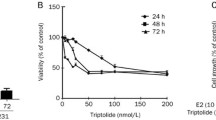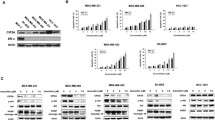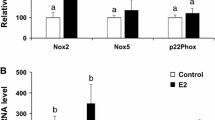Abstract
Apoptosis induction by the pure antiestrogen faslodex, also known as ICI 182780 (ICI), is associated with an effective down-regulation of Bcl-2 expression in the human breast cancer cell line MCF-7. Recent observations point out that beside members of the Bcl-2 family also the TNFR1 signaling pathway may be involved in apoptosis induction by antiestrogens. In this report we have analyzed the expression of members of the TNFR1 signaling pathway during the apoptotic process induced by the pure antiestrogen faslodex and by tamoxifen (Tam) in MCF-7 breast cancer cells. Treatment with 10−7 M ICI or 10−7 M Tam leads to a time dependent increase of TNFR1 and TRADD steady-state mRNA levels in MCF-7 cells. In contrast, Bcl-2 expression was strongly decreased following administration of ICI but only weakly after administration of Tam. Western blot analysis and studies by the use of fluorescence microscopy and flow cytometry revealed a time dependent induction of TNFR1 protein and cell surface expression in MCF-7 cells in response to treatment with ICI. To investigate if TNFR1 is functionally involved in apoptosis induction by antiestrogens, we tested whether TNFR1 blocking antibodies can counteract the growth inhibitory action of Tam and ICI. Coincubation of MCF-7 cells with antiestrogens (ICI or Tam) and blocking TNFR1 antibodies lead to an increase in cell viability. Our results provide evidence for a cross talk between the TNFR1 signaling pathway and antiestrogens during the process of apoptosis induction in MCF-7 breast cancer cells. The superiority of the pure antiestrogen ICI to induce apoptosis in MCF-7 cells may result from its capability to modulate the induction of apoptosis via Bcl-2 as well as TNF-associated signal transduction pathways.
Similar content being viewed by others
References
Furr BJ, Jordan VC: The pharmacology and clinical uses of tamoxifen. Pharmacol Ther 25: 127–205, 1984
Jaiyesimi IA, Buzdar AU, Decker DA, Hortobagyi GN: Use of tamoxifen for breast cancer: twenty-eight years later. J Clin Oncol 13: 513–529, 1995
Gottardis MM, Robinson SP, Satyaswaroop PG, Jordan VC: Contrasting actions of tamoxifen on endometrial and breast tumor growth in the athymic mouse. Cancer Res 48: 812–815, 1988
Jordan VC, Morrow M: Should clinicians be concerned about the carcinogenic potential of tamoxifen? Eur J Cancer 30A: 1714–1721, 1994
Assikis VJ, Neven P, Jordan VC, Vergote I: A realistic clinical perspective of tamoxifen and endometrial carcinogenesis. Eur J Cancer 32A: 1464–1476, 1996
Osborne CK, Fuqua SA: Mechanisms of tamoxifen resistance. Breast Cancer Res Treat 32: 49–55, 1994
Johnston SR, Dowsett M, Smith IE: Towards a molecular basis for tamoxifen resistance in breast cancer. Ann Oncol 3: 503–511, 1992
Wilson JW, Wakeling AE, Morris ID, Hickman JA, Dive C: MCF-7 human mammary adenocarcinoma cell death in vitro in response to hormone-withdrawal and DNA damage. Int J Cancer 61: 502–508, 1995
Warri AM, Huovinen RL, Laine AM, Martikainen PM, Harkonen PL: Apoptosis in toremifene-induced growth inhibition of human breast cancer cells in vivo and in vitro. J Natl Cancer Inst 85: 1412–1418, 1993
Schulze-Osthoff K, Ferrari D, Los M, Wesselborg S, Peter ME: Apoptosis signaling by death receptors. Eur J Biochem 254: 439–459, 1998
Reed JC: Regulation of apoptosis by bcl-2 family proteins and its role in cancer and chemoresistance. Curr Opin Oncol 7: 541–546, 1995
Korsmeyer SJ: Regulators of cell death. Trends Genet 11: 101–105, 1995
Yang J, Liu X, Bhalla K, Kim CN, Ibrado AM, Cai J, Peng TI, Jones DP, Wang X: Prevention of apoptosis by Bcl-2: release of cytochrome c from mitochondria blocked. Science 275: 1129–1132, 1997
Kluck RM, Bossy-Wetzel E, Green DR, Newmeyer DD: The release of cytochrome c from mitochondria: a primary site for Bcl-2 regulation of apoptosis. Science 275: 1132–1136, 1997
Diel P, Smolnikar K, Michna H: The pure antiestrogen ZM 182780 is more effective in the induction of apoptosis and down regulation of BCL-2 as tamoxifen in MCF-7 cells. Breast Cancer Res Treat 58: 87–97, 1999
Jeoung DI, Tang B, Sonenberg M: Effects of tumor necrosis factor-alpha on antimitogenicity and cell cycle-related proteins in MCF-7 cells. J Biol Chem 270: 18367–18373, 1995
Cai Z, Bettaieb A, Mahdani NE, Legres LG, Stancou R, Masliah J, Chouaib S: Alteration of the sphingomyelin/ceramide pathway is associated with resistance of human breast carcinoma MCF7 cells to tumor necrosis factor-alphamediated cytotoxicity. J Biol Chem 272: 6918–6926, 1997
Nagata S: Apoptosis by death factor. Cell 88: 355–365, 1997
Chinnaiyan AM, O'Rourke K, Yu GL, Lyons RH, Garg M, Duan DR, Xing L, Gentz R, Ni J, Dixit VM: Signal transduction by DR3, a death domain-containing receptor related to TNFR-1 and CD95. Science 274: 990–992, 1996
Wallach D, Boldin M, Varfolomeev E, Beyaert R, Vandenabeele P, Fiers W: Cell death induction by receptors of the TNF family: towards a molecular understanding. FEBS Lett 410: 96–106, 1997
Hsu H, Xiong J, Goeddel DV: The TNF receptor 1-associated protein TRADD signals cell death and NF-kappa B activation. Cell 81: 495–504, 1995
Sambrook J, Fritsch EF, Maniatis T: Molecular Cloning – A Laboratory Manual, 2nd edition. Cold Spring Harbor Laboratory, Cold Spring Habor, 1989
Murphy LD, Herzog CE, Rudick JB, Fojo AT, Bates SE: Use of the polymerase chain reaction in the quantitation of mdr-1 gene expression. Biochemistry 29: 10351–10356, 1990
Knauthe R, Diel P, Hegele-Hartung C, Engelhaupt A, Fritzemeier KH: Sexual dimorphism of steroid hormone receptor messenger ribonucleic acid expression and hormonal regulation in rat vascular tissue. Endocrinology 137: 3220–3227, 1996
Nicoletti I, Migliorati G, Pagliacci MC, Grignani F, Riccardi C: A rapid and simple method for measuring thymocyte apoptosis by propidium iodide staining and flow cytometry. J Immunol Methods 139: 271–279, 1991
Kyprianou N, English HF, Davidson NE, Isaacs JT: Programmed cell death during regression of the MCF-7 human breast cancer following estrogen ablation. Cancer Res 51: 162–166, 1991
Aggarwal S, Gollapudi S, Gupta S: Increased TNF-alphainduced apoptosis in lymphocytes from aged humans: changes in TNF-alpha receptor expression and activation of caspases. J Immunol 162: 2154–2161, 1999
Jacobson SH, Lu Y, Brauner A: Tumor necrosis factor soluble receptors I and II and the interleukin-1 receptor antagonist in acute pyelonephrotis in relation to bacterial virulence-associated traits and renal function. Nephrol Dial Transplant 11: 2209–2214, 1996
Baxter GT, Kuo RC, Jupp OJ, Vandenabeele P, MacEwan DJ: Tumor necrosis factor-alpha mediates both apoptotic cell death and cell proliferation in a human hematopoietic cell line dependent on mitotic activity and receptor subtype expression. J Biol Chem 274: 9539–9547, 1999
Cope AP, Gibbons DL, Aderka D, Foxwell BM, Wallach D, Maini RN, Feldmann M, Brennan FM: Differential regulation of tumour necrosis factor receptors (TNF-R) by IL-4; upregulation of P55 and P75 TNF-R on synovial joint mononuclear cells. Cytokine 5: 205–212, 1993
Hsu SH, Tsai TR, Lin CN, Yen MH, Kuo KW: Solamargine purified from Solanum incanum Chinese herb triggers gene expression of human TNFRI which may lead to cell apoptosis. Biochem Biophys Res Commun 229: 1–5, 1996
Jiang Y, Woronicz JD, Liu W, Goeddel DV: Prevention of constitutive TNF receptor 1 signaling by silencer of death domains. Science 283: 543–546, 1999
Kandouz M, Lombet A, Perrot JY, Jacob D, Carvajal S, Kazem A, RosteneW, Therwath A, Gompel A: Proapoptotic effects of antiestrogens, progestins and androgen in breast cancer cells. J Steroid Biochem Mol Biol 69: 463–471, 1999
Zhang GJ, Kimijima I, Onda M, Kanno M, Sato H, Watanabe T, Tsuchiya A, Abe R, Takenoshita S: Tamoxifen-induced apoptosis in breast cancer cells relates to down-regulation of bcl-2, but not bax and bcl-X(L), without alteration of p53 protein levels. Clin Cancer Res 5: 2971–2977, 1999
Pan G, Vickers SM, Pickens A, Phillips JO, Ying W, Thompson JA, Siegal GP, McDonald JM: Apoptosis and tumorigenesis in human cholangiocarcinoma cells. Involvement of Fas/APO-1 (CD95) and calmodulin. Am J Pathol 155: 193–203, 1999
Turley JM, Fu T, Ruscetti FW, Mikovits JA, Bertolette DC 3rd, Birchenall-Roberts MC: Vitamin E succinate induces Fas-mediated apoptosis in estrogen receptor-negative human breast cancer cells. Cancer Res 57: 881–890, 1997
Komi J, Lassila O: Antiestrogens enhance tumour necrosis factor receptor 2 (TNF-R2) expression and TNF-R2 mediated proliferation in activated T cells. Scand J Immunol 48: 254–260, 1998
Ansar Ahmed S, PenhaleWJ, Talal N: Sex hormones, immune responses, and autoimmune diseases. Mechanisms of sex hormone action. Am J Pathol 121: 531–551, 1985
Rights and permissions
About this article
Cite this article
Smolnikar, K., Löffek, S., Schulz, T. et al. Treatment with the pure antiestrogen faslodex (ICI 182780) induces tumor necrosis factor receptor 1 (TNFR1) expression in MCF-7 breast cancer cells. Breast Cancer Res Treat 63, 249–259 (2000). https://doi.org/10.1023/A:1006490416408
Issue Date:
DOI: https://doi.org/10.1023/A:1006490416408




